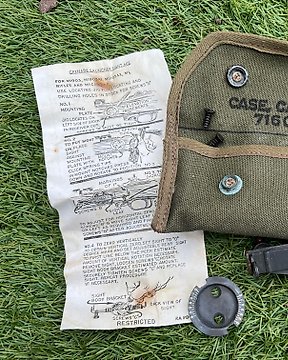
Vereinigte Staaten von Amerika - WW2 USA M1 Karabiner / M1 Garand Granatwerfer Visier – Tasche/Anleitung – Infanterie – - Militärausrüstung - 1944
Nr. 81806361

Nr. 81806361

Offered for auction is a nice piece of equipment for the infamous M1 Rifle and Carbine: the Rifle Grenade Launcher sight, in original packaging and in pouch from around 1944; they were only made in 1944. For M1903, M1903A1, M1903A#, M1 Rifles and M1 Carbine. Pouch is made of two different shade of dark OD green web and marked with part number. The metal mount and the sight come with the oil cloth instruction sheet and even the two original screws. This example is nicely used and has beautiful aging!
Great sight for the US WW2 collector!
The M1 carbine (formally the United States Carbine, Caliber .30, M1) is a lightweight[7] semi-automatic carbine that was a standard firearm for the U.S. military during World War II. After the initial Army testing in August 1941, the Winchester design team set out to develop a more refined version. Williams participated in the finishing of this prototype. The second prototype competed successfully against all remaining carbine candidates in September 1941, and Winchester was notified of their success the next month. Standardization as the M1 carbine was approved on October 22, 1941. This story was the loose basis for the 1952 movie Carbine Williams starring James Stewart. Contrary to the movie, Williams had little to do with the carbine's development, with the exception of his short-stroke gas piston design. Williams worked on his own design apart from the other Winchester staff, but it was not ready for testing until December 1941, two months after the Winchester M1 carbine had been adopted and type-classified. Winchester supervisor Edwin Pugsley conceded that Williams' final design was "an advance on the one that was accepted", but noted that Williams' decision to go it alone was a distinct impediment to the project,[14] and Williams' additional design features were not incorporated into M1 production. In a 1951 memo written in fear of a patent infringement lawsuit by Williams, Winchester noted his patent for the short-stroke piston may have been improperly granted as a previous patent covering the same principle of operation was overlooked by the patent office.[14]
So kaufen Sie auf Catawiki
1. Etwas Besonderes entdecken
2. Höchstgebot abgeben
3. Sichere Zahlung durchführen